 Unexplained
Files: Dave Grohl and all the Rest Unexplained
Files: Dave Grohl and all the Rest
Pop Culture Goo
By RAR
Fame
has this way of cutting the famous off from those who gave it to
them. It is the psychological equivalent of green money and
exists with similar dynamics. Wealthy people tend to wall
themselves off from the less wealthy and the poor, and famous
people tend to wall themselves off from the less famous and the
obscure. It is probable that neither class can feel understood by anyone outside
their class. There is a pecking order to life and the peckers at
the top are cloistered in such a way that they may, in their
defenses, become far less engaging and interesting than
those at the bottom. Obviously most of us will never know for
sure, beyond what we can deduce from the autobiographies of the
rich and famous, but then they are typically pretty tedious affairs.
They tend to reveal the dreams and machinations of their
subjects to be about as compelling as those of the non-rich,
non-famous, distinguished only by amazing good fortune. This is
why we admire them: they are proof of a mythology, examples of
people for whom dreams really did come true.
Anyone who strives and suspects that
they are getting nowhere doing it, dreams of the big break.
I was once upbraided in a fiction
writing class by a professor who was furious at me for writing a
short story in which the principal player imagined meeting “the
right people” who could make him a success in the literary
world. He seemed to be offended that my premise challenged his
own claim to his exalted position on campus, and on the
university faculty, as a literary master. The truth was, hardly
anyone had ever heard of him, I’ve now forgotten anything but
his first name – “Harry” – and he wasn’t much of a writer at
all. He was more of a confectionary vendor, a waiter with a
serving tray of pastes in popular flavors. He had identified a
soft target and constructed his crap to tastes, and it had
worked well enough to get him an easy job. It was as if he had
died and gone to heaven, where he had free rein to hustle coeds.
And damnit, he had earned this through his own God-given
brilliance! There was no assistance needed at all.
The point is, the story of life is
all about the journey, not the arrival, because the truth is
that we never really get to where we are going. We know this
inherently, and it is a big part of why some of us like to
imagine that heaven awaits us after our mortal lives are over
because it’s all just bleeding hell down here. There must be
something good out there awaiting us, surely; some justified
reward for all of us who never got their just rewards in life.
People long for rest and peace, the
Elysian fields, the Forbes 500, and the Rock’n Roll Hall of
Fame.
Surely we notice that the rich and famous
appear to stagnate into
caricatures of themselves almost as soon as they close the gates
behind them, because there is no forward journey for them.
In shameful fact, following or watching them represents a kind of
fetid voyeurism. Their
lives become exercises in clutching tightly to what they have
gained. The drama tends to take place without them, among the
rest of the world all around them for whom striving remains
everything, even survival. No one cares if the rich and famous
fall to rot, because they probably already got more rare
fruit than they ever deserved in the first place. But for those
people who continue to bang up against walls, to get knocked
down, and then to get back up and keep going, because that is
their only choice, we have tremendous respect. We tend to
understand the rolling wrecks that are their lives. We recognize
their panic, their exhilarations, and we feel their pains. We
find them far more enthralling, and so the Creative Culture
Journal tends to tell their stories and display their wares
before all other.
In the pop culture world, fame is a
fleeting thing, far more tenuous than wealth, which however
disgusting tends to regenerate itself. The well-to-do tend to
become more well-to-do simply because they are already
well-to-do. It is this radioactive form of reproduction that
mutates the wealthy into such horrid distortions of human life,
but their control of the currency of our existence allows them
to prevail, to carry on.
Popularity, on the other hand, tends
to ebb and flow. You can be Kei$ha
one day, and just plain old Keisha
the next. You can become Lady Gaga,
with Tony Bennett, after once having been
Lady Gaga with a swooning
cadre of little monsters. You can become
Madonna, which must be its own special brand of
purgatory wherein Nora
Desmond yearns for one more close-up that doesn’t
make children shield themselves from the horror.
America has devised a special buffer
against the sickness of faltering fame. We have halls of fame
all over the place where we recognize people who are already
famous.
Hollywood does an annual version of this with the the
Grammys, the Golden Globe Awards and the Academy Awards, which
capture brief solar flares of publicity brilliance before the
moment passes and their stars become mere faces on some
subscription service. Those are the brightest flashes of
recognition, however fleeting, but at the lower tiers we just
have those halls where we immortalize people who we would
otherwise forget. Of these, only the
Baseball Hall of Fame in Cooperstown, New York, seems
to have any real integrity, because baseball is old, engrained
in our culture, and the boys honored there truly have only a few
summers before they themselves become old and must melt back
into the general population. It is nearly impossible to become
enshrined in Cooperstown. Pete Rose
can’t do it, nor can Mark McGwire
or Barry Bonds, though their
records of success were Herculean. They just weren’t good enough
human beings, and Cooperstown has a standard regarding that.
While it may be American to pedal baloney when it comes to
sales, it is also quite American to draw the line on some
things, and the Baseball Hall of Fame only recognizes godly
types, beyond just mere gods. One can argue with their
stodginess, but in terms of integrity they make all other
competing halls of fame seem cheap, like tourist attractions
built on questionable folklore; like the
Fouke Monster Festival of Jonesville, Arkansas,
or the Hatfield and McCoy Reunion
Festival in Williamson, West Virginia.
In Colorado there is the Music Hall
of Fame, which is a relatively recent confection, apparently
mounted as a tourist attraction by the survivors of the former
Feyline Productions concert
production company, which for years brought big-name musical
acts to the state. Denver has, from its mining & mineral beginnings, been a town
committed to imported entertainment, and over time a number of movers and
shakers have moved into the Denver/Boulder area. The University
of Colorado has been a significant magnet of talent. Some creatives
have emerged
from that engine of education, including musical acts
The Astronauts and
Flash Cadillac and the Continental Kids.
A fan base developed from out of that college town, and others
along the front range of the Rocky Mountains, and most
particularly from among the many ski resorts that host the
state's energetic
tourism industry.
There developed a musical culture in
Colorado that has appealed to a far-flung set of music industry
types, so Colorado has long been a retirement home for people
from the mainstream entertainment industry. Englishman
Joe Cocker died there this
year, on a ranch outside Crawford, Colorado (pop. 430).
(This will almost certainly land him a spot in some future
edition of the Colorado Music Hall of Fame.)
James Guercio, of
Chicago fame, retired to
Colorado decades ago but still operated a boutique recording
business through Caribou Ranch Recording Studio, which catered to
other famous people (Billy Joel, Stevie
Wonder, Elton John) who came to record in mountainous
seclusion from their real lives in the real world. It has always
been a place where jazz musicians went to their rest. In the
late 1960s and early 1970s it became a retreat for refugees from
the Los Angeles music community; particularly those who had
stood in the flames of competition on the coasts, been fried,
and so wished for some regenerative Rocky Mountain High, ala
John Denver. That never
really happened for any of them, of course, because Colorado for
them was largely a place to go to think back on the good old
days, not a place for creating good old days anew. Those places
are always on the coasts, where the ports of entry and points of
embarkation are situated, from which the new age is launched as
a matter of practical economics. The digital age has not really
flattened the world as much as some may wish to imagine, for in
the U.S. the
mother lodes of information technology still reside on the east
and west coasts, with hardly more than tendril connections to
places like Austin and Boulder. Music is inescapably a product
of information technology, and so that industry, too, continues
to be a denizen of the near oceans and the rocky shores.
The Colorado Music Hall of Fame,
previous to this year, featured The
Serendipity Singers and
Sugarloaf. Let that sink in for a minute.
Judy Collins was in it, too,
and John Denver: pretty
syrupy stuff, I think you’d agree. The potential list of
inductees is limited by the musical fortunes of the state, which
have not been great; in fact, probably not great enough to
require a hall of fame to keep it all straight. (You could
actually do it on a napkin.) Filling out the
roster has been an exercise in expanding tastes and redefining
barriers. Of course,
horrible taste in music comes as pleasantly to some as cash
comes to others. It is endemic to hall of fame processes, to wit
this snipe below at the big Rock'n Roll Hall of Fame in Cleveland,
which also has a thickly padded roster, though for entirely different
reasons.
December
16, 2014, Salon Magazine Headline:
The Rock and Roll Hall of
Fame is a mess: Why does the induction committee have such
bad taste?
Here at the CCJ
we have railed against our “national” Rock’n Roll Hall of Fame,
in Cleveland, for reasons perfectly described by former
Talking Head
Chris Franz. He told
the Huffington Post – “…when we talk about the R&R HOF we are
talking about a celebration of the music industry. It is a night
when the music industry can get dressed up, spend a ton of money
for a table and say to themselves, ‘See that band up there?
They're up there because of me and my people. We took care of
business for them so that they could write songs, do tours, have
their records played on the radio, and be Rock Stars.’" And
that from a member of the Talking Heads who has been enshrined
in that particular Hall of Fame.
Why would famous people need to
be recognized in a hall of fame anyway? Aren’t their whole lives
sort of like halls of fame, but ones in which they take the cash
receipts themselves? So what is any other hall of fame?
The answer may be found at the
Red Rocks
Amphitheatre, where
the Colorado Music Hall of Fame has set up a museum of music
industry artifacts, presumably to capitalize on the concert
traffic that the old Feyline Productions played such a key role
in developing.
This year the Colorado Music Hall
of Fame honored
Poco,
Manassas, and the
Nitty Gritty
Dirt Band, the latter
of which featured, and still features,
John McEuen,
who is featured in this edition of the CCJ. None of those bands
are actually from Colorado, but rather are from a gooey L.A.
country-rock community of late 1960s derivation. That really
also includes
Firefall,
also inducted, whose original lineup really only boasted one Coloradoan, that being
Jock Bartley,
from Boulder. Everyone else in that initial lineup had retired
to the state from the coasts. (Bartley caught some updraft when
he replaced Tommy Bolin in
the rock band Zephyr.)
Zephyr was great but somehow never went anywhere commercially,
which qualifies them for our (i.e., the CCJ Hall of
Fame, as if) Colorado Hall of Fame. Manassas
never sold any records either, and they weren't really even a
Colorado band, but neither lack of record sales nor
lack of residence qualifies
them for our roster of HOF-worthy Coloradoans. It seems feasible that none of these
types of conversations swirl among the four-or-five
non-musicians on the Colorado Music Hall of Fame selection
committee. The Cleveland Rock'n Roll Hall of Fame is the same
way, with a few industry insiders choosing the inductees.
Use this link to get a sense for the makeup of their Board
of Directors. It's not exactly the staff of Julliard. So it is
with the Colorado Music Hall of Fame, where Gene and Jeff and
who knows who set the laurels. (These, by the way, are the
jokes, should you be having difficulty following along.)
Some of their selectees do have
merit.
The Nitty
Gritty Dirt Band is a
special case because they have always been devoted to what
brought ‘em, so to speak, which was the country music so
brilliantly featured on their Will the Circle Be Unbroken
albums. They have never really been cool, but they have always
been hip. With great integrity and excellent musicianship, they
have earned the allegiances of country music masters, and they
have contributed to American culture with undeniable modesty and
honesty. They are in a separate class, rather like those
distinguished by the Cooperstown Hall of Fame, where entry is
based also on character.
But what about these others?
Poco
was peopled by folks who weren’t mean enough to get into
The Eagles,
outré enough for
Crosby,
Stills, Nash and Young,
or who simply arrived too late for
The Byrds,
but still had superb industry connections. Poco was born to be a
big deal. Richie Furay had
emerged as a promising light released from the solar flare that
was Buffalo Springfield, where he was a sideman to
Stephen Stills and
Neil Young, but he emerged
rather prophetically as a guy who could contribute as long as
the rest of the band wasn't around. That's how he had recorded
"Kind Woman" for Buffalo Springfield's swan song album, and so
he became psychically adrift about the time people started
paying attention to him. (No coincidence that he became a pastor
just a few years later.) He saw Poco as his band, which made it
a contentious affair and left it artistically in a certain place
that could not quite crack the top 50 of the Billboard charts.
The band had the kind of record company support that was going
to get them played on certain radio stations, but industry
insiders began to grow doubtful about the band's actual sales
potential. People like Jim Messina
kept getting angry at Richie and kept leaving. Poco never became
other than a second tier act, in terms of headliner status,
because they were not doing anything special musically. It was
in their DNA to sound just like a hundred other AM radio bands.
They were of a kind that came out of a Southern California country music
incubator that started initiates off in folk, bluegrass or jug
bands, slowly introduced them to the Fender bass and traps, and
eventually to electric guitars. Chris
Hillman was one such initiate, and
Michael Clarke, the other part
of The Byrds' rhythm
section, was another. Hillman came out of a bluegrass band, and
Clarke was playing nothing more than the bongos when he met
Roger McGuinn and became the
drummer for The Byrds. They all came together at places like the
Troubador in L.A. Those who could keep company
congealed into the goo that defined ‘70s-era AM radio (The
Eagles, CSNY, Poco, Firefall, and that latter-day version of The
Byrds) and those who went solo were
largely lost to history (Jackson
Browne, J.D. Souther).
There was something fey about all
of those acts, a kind of effete panzy-boy modality in which the
songwriters were all self-absorbed dreamers riding romantic
streaks in between snorting lines of blow.
It was like music from reformed hippies who dreamed of a life
around testicles, along with some girls, with neither being the kind
you’d want to spend time with. Introspective simps, I think you’d call them.
That, by the way, was not Colorado's fault, though the state has
claimed so many of these acts, because whatever had gotten into
the drinking supply of these early-70s country rockers was mined
out of Southern California, so the crime is theirs. Ironically, I
doubt that there is now a Californian below the age of 60 who would
even know who Poco was, and that might even be true in Colorado,
too. On the other hand, I have been wrong
before. Who knew that people would pay real money to see
Steve Miller and
Journey in 2014, when each
were punch lines back in their heydays?
Life generates its own hall of
fame. Run your Microsoft Word
spell checker and it will properly recognize the band name The Byrds, but not Poco, who gets renamed “Pico”, Firefall, who gets
renamed “Fireball”, or J.D. “Southern”.
Microsoft’s default settings may
not be the last word in cultural legitimacy, but still.
The next Colorado Music Hall of
Fame inductees have already been announced:
Dan Fogleberg
and
Joe Walsh.
Joe Walsh (who is being inducted on the fame of his band
Barnstorm, if by some miracle
you remember them), who was born in Kansas and largely raised in
Ohio and New York, did live for a time in Boulder, Colorado,
even losing a daughter there in a horrible car crash in 1971.
There is a plaque to her in a park in North Boulder. Personally,
I have always admired and respected Walsh and would tend to give
a tip of the hat to any honors he may garner. I’m not sure he is
really a Colorado guy, though. Dan Fogleberg was produced by Joe
Walsh, and was not a Colorado native either (he was from
Illinois by way of Tennessee), though he lived in Colorado after
working as a Nashville session musician. He was not born of that
Southern California fever that gripped Poco, Firefall,
Souther-Hillman-Furay, and many others like them, but he still gave the world some
of the most self-conscious, self-indulgent pap in AM music
history, with songs like “Leader of the Band” and "Same Old Lang Syne".
Fogleberg died in 2007 in Maine.
He was on a par with Terry Jacks
(“Seasons In the Sun”). Remember him? He’s in the
Canadian Music Hall of Fame. |

Looming Large in Colorado
Musical Legend
The view from Wikipedia...
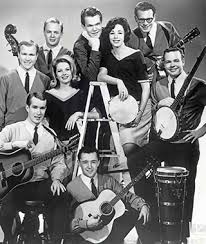 The
Serendipity Singers were a 1960s American folk group,
similar to The New Christy Minstrels. Their debut single "Don't
Let the Rain Come Down" was a Top Ten hit and received the
group's only Grammy nomination in 1965. The
Serendipity Singers were a 1960s American folk group,
similar to The New Christy Minstrels. Their debut single "Don't
Let the Rain Come Down" was a Top Ten hit and received the
group's only Grammy nomination in 1965.
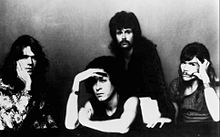 Sugarloaf
was an American rock band in the 1970s. The band, which
originated in Denver, Colorado, scored two Top 10 hits, with the
singles "Green-Eyed Lady" and "Don't Call Us, We'll Call You". Sugarloaf
was an American rock band in the 1970s. The band, which
originated in Denver, Colorado, scored two Top 10 hits, with the
singles "Green-Eyed Lady" and "Don't Call Us, We'll Call You".
Judy Collins' debut album A Maid of Constant Sorrow
was released in 1961, but it was her cover of Joni Mitchell's
"Both Sides, Now", released on her 1967 album Wildflowers,
that gave Collins international prominence. The single hit the
Top 10 on the Pop Singles chart , and won Collins her first Grammy
Award for Best Folk Performance. She enjoyed further success with covers of
"Someday Soon", "Amazing Grace", and "Cook With Honey". Collins
experienced the biggest success of her career with her cover of
Stephen Sondheim's "Send in the Clowns" from her best selling 1975
album "Judith". The single charted on the Pop Singles chart in
1975, and then again in 1977, spending 27 nonconsecutive weeks
on the chart, and earned Collins a Grammy Award nomination for
Best Pop Vocal Performance, Female.
Folk Performance. She enjoyed further success with covers of
"Someday Soon", "Amazing Grace", and "Cook With Honey". Collins
experienced the biggest success of her career with her cover of
Stephen Sondheim's "Send in the Clowns" from her best selling 1975
album "Judith". The single charted on the Pop Singles chart in
1975, and then again in 1977, spending 27 nonconsecutive weeks
on the chart, and earned Collins a Grammy Award nomination for
Best Pop Vocal Performance, Female.
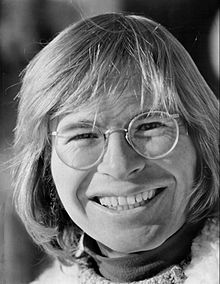 John
Denver was an American singer-songwriter, actor,
activist and humanitarian, whose greatest commercial success was
as a solo singer, starting in the 1970s. He was one of the most
popular acoustic artists of the decade and one of its
best-selling artists. By 1974, he was firmly established as
America's best-selling performer, and AllMusic has described
Denver as "among the most beloved entertainers of his era". After
traveling and living in numerous locations while growing up in
his military family, Denver began his music career in folk music
groups in the late 1960s. Throughout his life, Denver recorded
and released approximately 300 songs, about 200 of which he
composed, with total sales of over 33 million. John
Denver was an American singer-songwriter, actor,
activist and humanitarian, whose greatest commercial success was
as a solo singer, starting in the 1970s. He was one of the most
popular acoustic artists of the decade and one of its
best-selling artists. By 1974, he was firmly established as
America's best-selling performer, and AllMusic has described
Denver as "among the most beloved entertainers of his era". After
traveling and living in numerous locations while growing up in
his military family, Denver began his music career in folk music
groups in the late 1960s. Throughout his life, Denver recorded
and released approximately 300 songs, about 200 of which he
composed, with total sales of over 33 million.
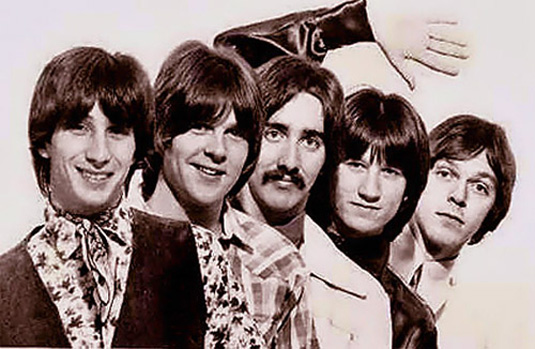
Poco
- Their first album, Pickin' Up the Pieces (1969), is considered
a seminal album of the country rock genre. However, the album
performed weakly, peaking at No. 63 on Billboard album chart.
Their second studio album Poco (1970) again resulted in low
sales, peaking at No. 58. The band's next album, Deliverin' (or DeLIVErin' as it sometimes represented), picked up moderate
airplay, Furay's "C'mon" hitting No. 69. Deliverin’ became Poco's first album to reach the Top 40 on the Billboard 200,
peaking at No. 26. Messina chose to leave the band in October
1970, feeling Furay exhibited too much control over the group's
sound and left the band to return to studio production. The
realigned Poco, now on its third lineup on just its fourth
album, hired Steve Cropper as producer and released From the
Inside (Poco album) (1971). Again, poor sales were the result as
the release landed at No. 52. The band and its management were
dissatisfied with Cropper's production and hired Jack
Richardson, who oversaw the next three albums, beginning with A
Good Feelin' to Know (1972). The band built the LP around the
title track, a popular concert tune, but the single failed to
chart. The album itself peaked at No. 69. As a result, Furay
became increasingly discouraged with Poco's prospects,
especially since ex-bandmates Stills, Young, Meisner and Messina
were so successful with their respective groups. In an April 26,
1973 Rolling Stone magazine interview with Cameron Crowe he
vented that Poco was still a second-billed act and had not
increased its audience. After Furay's departure, the band
released their last two albums with Epic; Seven (1974) and
Cantamos (1974). The albums charted at No. 68 and No. 76
respectively. Poco left Epic after Cantamos and signed with
ABC-Dunhill Records. Head Over Heels was their first ABC
release, featuring Schmit's acoustic "Keep On Tryin'", which
became the group's most successful single to date, charting at
No. 50 on the Billboard Hot 100. Around the time of the release
of Head Over Heels, The Very Best of Poco was released as a
compilation album that documented the group's years with Epic.
Epic's release fought with Head Over Heals for attention though
neither charted very well, hitting No. 43 and No. 90,
respectively. The group's next ABC-Dunhill album was Rose Of
Cimarron which also failed to generate much enthusiasm and
peaked at No. 89. Another Epic release also came out in 1976,
the live album Live. Indian Summer was released the following
spring, peaking at No. 57, while the title track reached No. 50.
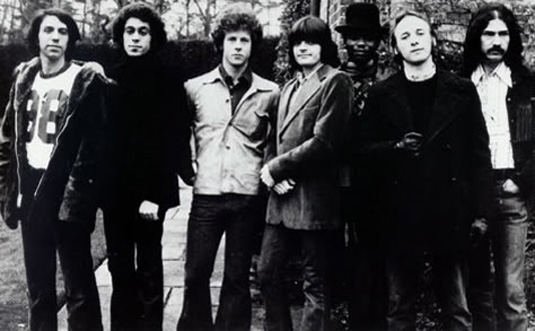 Manassas
was an American rock band formed by Stephen Stills in 1971.
Predominantly a vehicle for Stills’ artistic vision, the band
released two albums during its active tenure, 1972’s Manassas
and 1973’s Down the Road. The band dissolved in October
1973. Manassas
was an American rock band formed by Stephen Stills in 1971.
Predominantly a vehicle for Stills’ artistic vision, the band
released two albums during its active tenure, 1972’s Manassas
and 1973’s Down the Road. The band dissolved in October
1973.
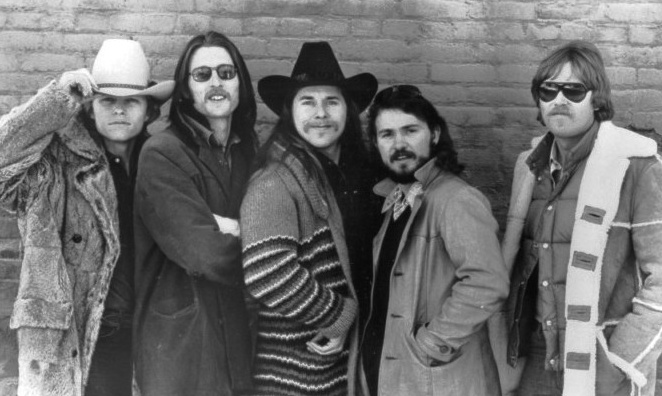 Firefall
is a rock band that formed in Boulder, Colorado in 1974. It was
founded by Rick Roberts, who had been in the Flying Burrito
Brothers, and Jock Bartley, who had been Tommy Bolin's
replacement in Zephyr. The band's biggest hit single, "You Are
the Woman", peaked at No. 9 on the Billboard charts in 1976.
Other hits included "Just Remember I Love You" (#11 in 1977),
"Strange Way" (#11 in 1978), "Cinderella" (#34 in 1977), "Headed
for a Fall" (#35 in 1980), and "Staying with It" (#37 in 1981)
with female vocalist Lisa Nemzo. Firefall
is a rock band that formed in Boulder, Colorado in 1974. It was
founded by Rick Roberts, who had been in the Flying Burrito
Brothers, and Jock Bartley, who had been Tommy Bolin's
replacement in Zephyr. The band's biggest hit single, "You Are
the Woman", peaked at No. 9 on the Billboard charts in 1976.
Other hits included "Just Remember I Love You" (#11 in 1977),
"Strange Way" (#11 in 1978), "Cinderella" (#34 in 1977), "Headed
for a Fall" (#35 in 1980), and "Staying with It" (#37 in 1981)
with female vocalist Lisa Nemzo.
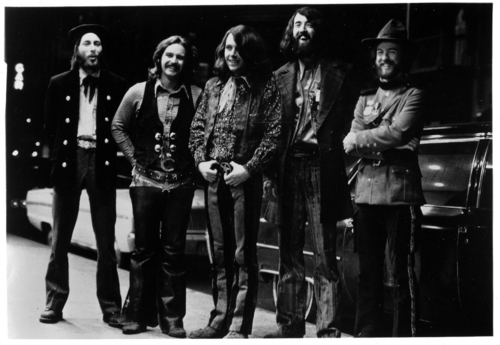 The
Nitty Gritty Dirt Band was founded around 1966 in
Long Beach, California by singer-guitarist Jeff Hanna and
singer-songwriter guitarist Bruce Kunkel who had performed as
the New Coast Two and later the Illegitimate Jug Band. The
band's first single, "Buy for Me the Rain," was a Top 40
success, and the band gained exposure on The Tonight Show
Starring Johnny Carson, as well as concerts with such disparate
artists as Jack Benny and The Doors. Their version of "Mr.
Bojangles" became the group's first hit, peaking at #9 on
Billboard's all genre Hot 100 chart. In May 1977 the Dirt Band
was the first American group allowed by the Soviet Union to tour
Russia, Armenia, Georgia and Latvia playing concerts and a
televised appearance that is estimated to have been watched by
145 million people. Their single "American Dream" with Linda
Ronstadt reached No. 13 on the popular music charts. The band
also appeared on Saturday Night Live, and, billed as The Toot
Uncommons, provided backing for Steve Martin on his
million-selling novelty tune, "King Tut." The albums Make a
Little Magic and Jealousy were released in 1980 and 1981, with
the single "Make a Little Magic" featuring Nicolette Larson
reaching the Top 25 on the pop chart. The band returned to its
original name and its country roots in 1982 with the lineup
paring down to Hanna, Fadden, McEuen and Jimmy Ibbotson
rejoining for recording sessions in Nashville, Tennessee for the
album Let's Go, which yielded the success "Dance Little Jean"
which was a Top 10 country hit. Carpenter rejoined the band in
1983 and the next album, 1984's Plain Dirt Fashion had the
band's first No. 1 success, "Long Hard Road (The Sharecropper's
Dream)". There were two more No. 1's: "Modern Day Romance"
(1985) and "Fishin' in the Dark" (1987). Other successful songs
were "Dance Little Jean" (1983); "I Love Only You" (1984); "High
Horse" (1985); "Home Again in My Heart," "Partners, Brothers and
Friends" and "Stand a Little Rain" (1986); "Fire in the Sky,"
"Baby's Got a Hold on Me" and "Oh What a Love" (1987); "Workin'
Man (Nowhere to Go)" and "I've Been Lookin'" (1988); and "Down
That Road Tonight" and "When it's Gone" (1989). The
Nitty Gritty Dirt Band was founded around 1966 in
Long Beach, California by singer-guitarist Jeff Hanna and
singer-songwriter guitarist Bruce Kunkel who had performed as
the New Coast Two and later the Illegitimate Jug Band. The
band's first single, "Buy for Me the Rain," was a Top 40
success, and the band gained exposure on The Tonight Show
Starring Johnny Carson, as well as concerts with such disparate
artists as Jack Benny and The Doors. Their version of "Mr.
Bojangles" became the group's first hit, peaking at #9 on
Billboard's all genre Hot 100 chart. In May 1977 the Dirt Band
was the first American group allowed by the Soviet Union to tour
Russia, Armenia, Georgia and Latvia playing concerts and a
televised appearance that is estimated to have been watched by
145 million people. Their single "American Dream" with Linda
Ronstadt reached No. 13 on the popular music charts. The band
also appeared on Saturday Night Live, and, billed as The Toot
Uncommons, provided backing for Steve Martin on his
million-selling novelty tune, "King Tut." The albums Make a
Little Magic and Jealousy were released in 1980 and 1981, with
the single "Make a Little Magic" featuring Nicolette Larson
reaching the Top 25 on the pop chart. The band returned to its
original name and its country roots in 1982 with the lineup
paring down to Hanna, Fadden, McEuen and Jimmy Ibbotson
rejoining for recording sessions in Nashville, Tennessee for the
album Let's Go, which yielded the success "Dance Little Jean"
which was a Top 10 country hit. Carpenter rejoined the band in
1983 and the next album, 1984's Plain Dirt Fashion had the
band's first No. 1 success, "Long Hard Road (The Sharecropper's
Dream)". There were two more No. 1's: "Modern Day Romance"
(1985) and "Fishin' in the Dark" (1987). Other successful songs
were "Dance Little Jean" (1983); "I Love Only You" (1984); "High
Horse" (1985); "Home Again in My Heart," "Partners, Brothers and
Friends" and "Stand a Little Rain" (1986); "Fire in the Sky,"
"Baby's Got a Hold on Me" and "Oh What a Love" (1987); "Workin'
Man (Nowhere to Go)" and "I've Been Lookin'" (1988); and "Down
That Road Tonight" and "When it's Gone" (1989).
 Joe
Walsh is an American singer, songwriter, composer,
multi-instrumentalist, and record producer. In a career spanning
more than 40 years, Walsh has been a member of five successful
rock bands: the Eagles, the James Gang, Barnstorm, The Party
Boys, and Ringo Starr & His All-Starr Band. He scored in May
1978, with "Life's Been Good", which featured his hit comedic
depiction of rock stardom, peaked at #12 on the US Billboard Hot
100 and remains to date his biggest solo hit. Walsh also
contributed "In the City" to The Warriors soundtrack in 1979, a
song penned and sung by Walsh that was later rerecorded for the
Eagles' studio album, The Long Run. Joe
Walsh is an American singer, songwriter, composer,
multi-instrumentalist, and record producer. In a career spanning
more than 40 years, Walsh has been a member of five successful
rock bands: the Eagles, the James Gang, Barnstorm, The Party
Boys, and Ringo Starr & His All-Starr Band. He scored in May
1978, with "Life's Been Good", which featured his hit comedic
depiction of rock stardom, peaked at #12 on the US Billboard Hot
100 and remains to date his biggest solo hit. Walsh also
contributed "In the City" to The Warriors soundtrack in 1979, a
song penned and sung by Walsh that was later rerecorded for the
Eagles' studio album, The Long Run.
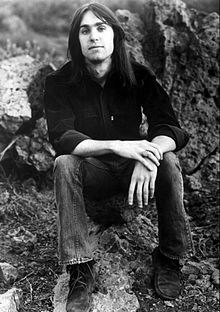 Dan
Fogleberg - The song "Part of the Plan" became
Fogelberg's first hit. After Souvenirs, he released a string of
gold and platinum albums, including Captured Angel (1975) and
Nether Lands (1977), and found commercial success with songs
such as "The Power of Gold". His 1978 Twin Sons of Different
Mothers was the first of two collaborations with jazz flautist
Tim Weisberg. 1979's Phoenix reached the Top 10, with "Longer"
becoming a #2 pop hit (and wedding standard) in 1980. The track
peaked at #59 on the UK Singles Chart – his sole entry on that
chart.[4] The album reached #42 on the UK Albums Chart, likewise
his only entry there. It was followed by a Top 20 hit "Heart
Hotels". Dan
Fogleberg - The song "Part of the Plan" became
Fogelberg's first hit. After Souvenirs, he released a string of
gold and platinum albums, including Captured Angel (1975) and
Nether Lands (1977), and found commercial success with songs
such as "The Power of Gold". His 1978 Twin Sons of Different
Mothers was the first of two collaborations with jazz flautist
Tim Weisberg. 1979's Phoenix reached the Top 10, with "Longer"
becoming a #2 pop hit (and wedding standard) in 1980. The track
peaked at #59 on the UK Singles Chart – his sole entry on that
chart.[4] The album reached #42 on the UK Albums Chart, likewise
his only entry there. It was followed by a Top 20 hit "Heart
Hotels".
|
